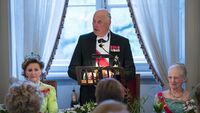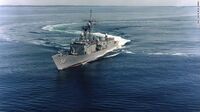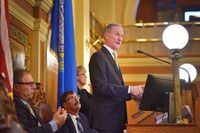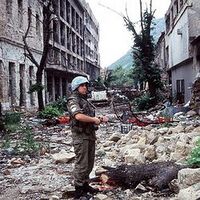Second Eskaeban Civil War
| Second Eskaeban Civil War | ||||||||
|---|---|---|---|---|---|---|---|---|
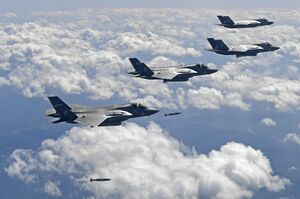 South Eskaeban F-35s during the Aseucia bombings | ||||||||
| ||||||||
| Belligerents | ||||||||
|
Support |
|
Support | ||||||
| Commanders and leaders | ||||||||
|
|
|
| ||||||
| Strength | ||||||||
|
|
|
| ||||||
| Casualties and losses | ||||||||
|
|
|
| ||||||
The Second Eskaeban Civil War was a civil military conflict between 28 March and 13 April 2019. The wars led to the formation of several Eskaeban successor states.
The war ended following the Treaty of Kyoma, which was signed and ratified on April 13, signed in the capital city of Kyoma in Wakoku.
Background
Assassination of the Basileus
On the 27th of March, 2019, Basileus Theodosius IV was shot and killed outside his official residence in Palimpela, shortly after the results of the 2019 Eskaeban Senatorial Elections were announced. The culprit is believed to be a prominent republican linked to the Eskaeban Terrorist Group "Oi Anthropoi!" or "The People!", who campaigned for an abolition of the monarchy and the establishment of a republic.
The assassination had immediate effects on the nation, as Theodosius had no heir to the throne. As a direct result of this, many Eskaeban nobles sought to increase the autonomy of their lands and decentralise the Eskaeban government to benefit themselves. None of the nobles could field a large enough army to make a realistic bid for the throne, however. So the power tussle continued.
The usurping
A day after the assassination, Ser Proclus Luscaris, the decorated leader of the Senate, usurped the throne by using a loophole in the Succession Act of 1814 that allowed him to be directly elected by the Senate, whom he controlled a large portion of. Proclus' claim was officially recognised by the Senate on March 28 and would go on to be coronated the next day in his hometown of Pirgos, to the north.
Angered by the sudden power grab and the usurping of the throne by Proclus, nobleman and half-brother of Theodosius Michael Theikos lay his claim to the throne, styling himself as Michael VIII. Michael broadcast his announcement far and wide, and soon the small baronies of the south began to swear fealty to their new Emperor, while many of the north's baronies bent the knee to Proclus and supported his claim.
First Phase (March 28 - April 4)
The first battle of the war would take place near the small town of Nissos, where some 2,000 South Eskaeban soldiers ambushed a castle guard of 760 guarding a Northern fort near the town. The battle proved to be a conclusive South Eskaeban victory under the storied guidance of Gazian general Aris Alanis. Fort Nissos was quickly sieged by ground artillery and air bombardment, and the fort fell on the dawn of March 29th.
The South Eskaebans continued to advance through central Eskaeba after their victory at Nissos, and would meet their first Northern army in true battle on the afternoon of April 1st at Bylleia. Neither of the belligerents had mechanical reinforcements with them, and the battle was fought using just infantrymen. The South Eskaebans again claimed victory in the battle and pushed the Northerners back to a defensive line just south of the large city of Aseucia. The Southerners did not continue their advance after the battle due to the heavy losses taken on both sides, and decided to reunite their armies and bring in fresh soldiers.
The Battle of Bylleia would not be the only conflict seen on the 1st of April, as the sea saw its share of combat on the same day, when a Northern fleet ambushed a smaller fleet of 7 Southern ships at Cape Cornelia. The battle was swift due to the overwhelming number advantage on the side of the Northerners, and resulted in the sinking of two southern frigates, SES Achaius and SES Olympia. The battle paved way for complete Northern naval dominance throughout the entire war, with the continuous blockade of the port cities of Idessos, Theodopolis and Vetranopolis lasting throughout the entire war. As a result of the blockade, many poorer citizens of South Eskaeba died of starvation, with the city of Theodopolis seeing over 2,000 starvation-related casualties alone.
Second Phase (April 4 - April 8)
On the afternoon of April 4, the autonomous province of Ceredonia, a long-standing minority in Eskaeba, declared independence under First Minister Kosta Gavrilovic at the Golzemia Address. Open war was declared against North Eskaeba, while peaceful diplomatic relations with the South were pursued immediately. Gavrilovic is quoted as saying "A society is only as great as its poorest citizens.", and, as an avid socialist and Ceredonian nationalist, set up the Grand Assembly of Ceredonians, consisting of 40 socialist and nationalist ministers, as an interim government to guide the nation through the conflict.
The Iron Axis (Artemia) got involved in the conflict on April 6, when a majority vote was achieved at the Iron Axis Headquarters in Castelencia, Matorre to send military and economic aid to North Eskaeba. However, it was clearly stated that direct military intervention was out of the question for the authoritarian alliance, citing that the risk of war with their rivals, the Artemian Union, was far too great. The announcement was extremely beneficial to the North, as most of the heavily industrialised areas and economic centres of Eskaeba had come under the control of the South, either through declared territory or through direct invasion. Following the Iron Axis' announcement, the newly-declared Republic of Ceredonia and South Eskaeba met in Gazia to discuss relations. President Gavrilovic and Michael VIII both signed the Treaty of Gazia, which recognised Ceredonian independence in South Eskaeba and created a binding non-aggression pact between the two states. The treaty was viewed by socialist ministers as necessary for the survival of Ceredonia, but was viewed by many nationalist ministers as a means of concession and surrender to the Eskaebans. Most notably, nationalist minister Obren Andric got into a heated debate with President Gavrilovic over the treaty during a meeting of the Grand Assembly.
A day after the intervention by the Iron Axis, South Eskaeban bombing raids commenced on several military outposts and ammunition depots in the city of Aseucia. The bombings were viewed with distrust by many states, and the civilian casualties of the bombings did not go unnoticed. The bombings were stopped after two days under direct order by Michael VIII.
The greatest offensive of the war so far came on the same day as the Aseucia bombings commenced. With 17,000 Northern troops advancing on the border of Ceredonia, this would also be the only battle that Ceredonia would be involved in. A small 4,000-strong, unorganised Ceredonian guerilla force was assembled as resistance to the invasion, but the northern armies were unphased, capturing large swathes of Ceredonian territory in the north and decisively defeating them at the Battle of Durmarë.
Late the same night, Sizhou announced that they would recognise Ceredonian independence and begin sending aid to the successor state. They took a similar stance to the Iron Axis with the North, and refused direct military involvement.
Third Phase (April 8 - April 13)
On April 8, Proclus I announced Operation Psellus, a full and complete offensive intended to completely wipe the South Eskaebans off the map. The operation began extremely successfully as the Northerners defeated a stray Southern army while being outnumber 3-to-1 in the Battle of Elaza. This revitalised the Northern armies and increased their morale, which had been diminishing after many defeats beforehand.
The Northerners utilised spearhead tactics, advancing hard and fast straight into Southern territory, coming just 30 miles north of Kameirurii at their greatest extent. These armies had marched through the night, hoping to intimidate the Southern forces into a retreat to Kameirurii, where they could lay siege to the city. The Southerners did not budge though, and attacked the weary Northern army inside the small city of Arakli, using their superior Leopard 2A6 tanks to deal large amounts of damage to the advancing armies.
April 10 marked a day of quiet on the fronts, but the war very much raged on diplomatically. Sizhouan aid had arrived at Slivets, a small port city in Ceredonia. Several army camps had been set up throughout Ceredonia with the aim of training civilians in basic military tactics as well as guerrilla and urban warfare. One such camp, the Zhao Zhe'shan Guerrilla Camp, in Golzemia, is the largest military camp in the Eskaeban subregion, able to train around 7,000 recruits at a time.
Human rights violations were also allegedly occurring in Ceredonia, with the Eskaebans living there being imprisoned, and in some extreme cases, tortured, since the foundation of the country.
Aid from the Iron Axis also arrived in Pirgos on the same day, and President Gavrilovic sent an official diplomatic telegram to the Chancellor of Adler asking for aid, which was ultimately rejected.
Acting Chancellor Epeius Aegon committed suicide on April 11 in the Basilica of Saint Michael in Vrosina, making a sacrifice to God that he believed would end the needless suffering of the war. Aegon was Proclus' close friend, and his suicide began the rapid mental deterioration of Proclus and the ultimate decline of the North.
The North saw initial success on the 11th as the North Eskaeban Marines carried out a successful landing at the port town of Rhea during the Rhea Landings, aimed at providing a corridor for a full siege of Idessos later in the war. While the Marines managed to take Rhea, their advance was halted there, and they were encircled by South Eskaeban garrisons at Idessos.
But the largest battle of the war would be fought today, near the city of Corfini. The battle saw over 50,000 combatants and over 6,000 casualties. Superior Southern firepower, discipline and morale would pave the way for their ultimate victory in the battle. The North's loss at the Battle of Corfini would mark the turning point in the war, and the downfall of North Eskaeba. After such a large defeat on the North's behalf, the armies of the South began a rapid advance north, recapturing most of the last lost during the first part of Operation Psellus in a mere few hours, and by the time night fell, the border was restored to what it was before. Following the loss at Corfini, Proclus issued a royal decree dismissing all of his generals, and took complete control of the armies himself. Some debate whether this was out of sheer rage and the loss or whether he truly believed that his armies were incompetent. Proclus ordered the public execution of the dismissed generals under charges of high treason the next morning in Haseion Square in Palimpela.
With Proclus' mental state bordering on complete collapse, the interim Chancellor Vasili Mexas asked the nation of Wakoku to host peace talks in its capital, Kyoma. The Treaty of Kyoma was signed and ratified by the three belligerents on April 13, and ratified by the new successor state created by the treaty (the Duchy of Kolbau, a buffer state) on April 14.
Aftermath
Eskaeban society had very much degraded after the war, with increasing levels of poverty, homelessness and unemployment across the nations. The war saw the abolition of the Eskaeban monarchy, who had ruled the Empire since 1404, and the establishment of a Provisional Republic, under Chancellor Georgia Gallou. The small Duchy of Kolbau is leading a rebuilding effort, due to its current territory harbouring most of the war's battles. Ceredonia is seeking closer relationships with Sizhou and other socialist nations, while Proclus was exiled to a remote place in the North Eskaeban mountains. The devastation from the war are expected to be felt for a long time, with the nations recovery programs not expected to conclude for the forseeable forture.
The Empire of Eskaeba had also come to a closure, with the Empire being split into four officially recognise successor states, the Provisional Republic of North Eskaeba, the Kingdom of South Eskaeba, the Republic of Ceredonia and the Duchy of Kolbau.
